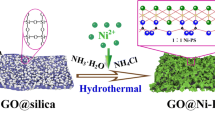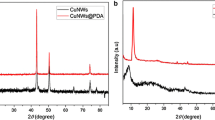Abstract
Designing ordered fillers arrangement and superior interfacial adhesion between fillers and matrix can improve the thermal conductivity (TC) of composites. Here, bioinspired dopamine chemistry was firstly used to reduce graphene oxide (GO) and introduce polydopamine nanoparticles on the surface of GO. Then, a well-aligned epoxy/reduced GO films (EP/RGFs) nanocomposites were prepared via the simple vacuum impregnation. Compared with the random distribution of fillers in a traditional blending composite, fillers were selectively distributed in matrix and continuous thermal conductive network structures were constructed in this strategy. As a result, the nanocomposite exhibited a high TC of 0.913 W m−1 K−1 which is 4.8 times higher than pure EP. In addition, curing kinetics showed that RGFs were similar to an amine-type curing agent that reacted with EP and bonded them tightly, and its nanocomposites reaction activation energy is lower than that of pure EP. These results indicated RGFs possessed excellent interface compatibility with EP and suppressing effectively the phonon scattering at the EP–RGFs interface. Cooling experiments showed that nanocomposites can reduce by about 10 °C for a hot source (80 °C), demonstrating it can transfer efficiently heat energy from the heat source. This study provides an effective method for the preparation of high-performance thermal management composites.









Similar content being viewed by others

References
Xu X, Chen J, Zhou J, Li B (2018) Thermal conductivity of polymers and their nanocomposites. Adv Mater 30(17):1705544
Zhang F, Feng Y, Qin M, Gao L, Li Z, Zhao F et al (2019) Stress controllability in thermal and electrical conductivity of 3D elastic graphene-crosslinked carbon nanotube sponge/polyimide nanocomposite. Adv Funct Mater 29:1901383
Xu Y, Wang X, Zhou J, Song B, Jiang Z, Lee EMY et al (2018) Molecular engineered conjugated polymer with high thermal conductivity. Sci Adv 4(3):eaar3031
Shanker A, Li C, Kim G-H, Gidley D, Pipe KP, Kim J (2017) High thermal conductivity in electrostatically engineered amorphous polymers. Sci Adv 3(7):e1700342
Chen H, Ginzburg VV, Yang J, Yang Y, Liu W, Huang Y et al (2016) Thermal conductivity of polymer-based composites: fundamentals and applications. Prog Polym Sci 59:41–85
Chen J, Huang X, Sun B, Jiang P (2019) Highly thermally conductive yet electrically insulating polymer/boron nitride nanosheets nanocomposite films for improved thermal management capability. ACS Nano 13(1):337–345
Yao Y, Zhu X, Zeng X, Sun R, Xu J-B, Wong C-P (2018) Vertically aligned and interconnected SiC nanowire networks leading to significantly enhanced thermal conductivity of polymer composites. ACS Appl Mater Interfaces 10(11):9669–9678
Feng Y, Hu J, Xue Y, He C, Zhou X, Xie X et al (2017) Simultaneous improvement in the flame resistance and thermal conductivity of epoxy/Al2O3 composites by incorporating polymeric flame retardant-functionalized graphene. J Mater Chem A 5(26):13544–13556
Suh D, Moon CM, Kim D, Baik S (2016) Ultrahigh thermal conductivity of interface materials by silver-functionalized carbon nanotube phonon conduits. Adv Mater 28(33):7220–7227
Chen W, Wang Z, Zhi C, Zhang W (2016) High thermal conductivity and temperature probing of copper nanowire/upconversion nanoparticles/epoxy composite. Compos Sci Technol 130:63–69
Han Z, Fina A (2011) Thermal conductivity of carbon nanotubes and their polymer nanocomposites: a review. Prog Polym Sci 36(7):914–944
Wang L, Qiu H, Liang C, Song P, Han Y, Han Y et al (2019) Electromagnetic interference shielding MWCNT-Fe3O4@Ag/epoxy nanocomposites with satisfactory thermal conductivity and high thermal stability. Carbon 141:506–514
Song N, Cao D, Luo X, Guo Y, Gu J, Ding P (2018) Aligned cellulose/nanodiamond plastics with high thermal conductivity. J Mater Chem C 6(48):13108–13113
Liu Y, Lu M, Wu K, Yao S, Du X, Chen G et al (2019) Anisotropic thermal conductivity and electromagnetic interference shielding of epoxy nanocomposites based on magnetic driving reduced graphene oxide@Fe3O4. Compos Sci Technol 174:1–10
Balandin AA (2011) Thermal properties of graphene and nanostructured carbon materials. Nat Mater 10(8):569–581
Seol JH, Jo I, Moore AL, Lindsay L, Aitken ZH, Pettes MT et al (2010) Two-dimensional phonon transport in supported graphene. Science 328(5975):213–216
Xin G, Yao T, Sun H, Scott SM, Shao D, Wang G et al (2015) Highly thermally conductive and mechanically strong graphene fibers. Science 349(6252):1083–1087
He Q, Wu S, Gao S, Cao X, Yin Z, Li H et al (2011) Transparent, flexible, all-reduced graphene oxide thin film transistors. ACS Nano 5(6):5038–5044
Qi X, Pu K-Y, Zhou X, Li H, Liu B, Boey F et al (2010) Conjugated-polyelectrolyte-functionalized reduced graphene oxide with excellent solubility and stability in polar solvents. Small 6(5):663–669
Peng L, Xu Z, Liu Z, Guo Y, Li P, Gao C (2017) Ultrahigh thermal conductive yet superflexible graphene films. Adv Mater 29(27):1700589
Liu ZQ, Peng PR, Liu ZH, Fang W, Zhou QZ, Liu XQ et al (2018) Electric-field-induced out-of-plane alignment of clay in poly (dimethylsiloxane) with enhanced anisotropic thermal conductivity and mechanical properties. Compos Sci Technol 165:39–47
Foley BM, Wallace M, Gaskins JT, Paisley EA, Johnson-Wilke RL, Kim JW et al (2018) Voltage-controlled bistable thermal conductivity in suspended ferroelectric thin-film membranes. ACS Appl Mater Interfaces 10(30):25493–25501
Dreyer DR, Park S, Bielawski CW, Ruoff RS (2010) The chemistry of graphene oxide. Chem Soc Rev 39(1):228–240
Hummers WS, Offeman RE (1958) Preparation of graphitic oxide. J Am Chem Soc 80(6):1339–1339
Dong L, Hu C, Song L, Huang X, Chen N, Qu L, Large-Area A (2016) Flexible, and flame-retardant graphene paper. Adv Funct Mater 26(9):1470–1476
Shin H-J, Kim KK, Benayad A, Yoon S-M, Park HK, Jung I-S et al (2009) Efficient reduction of graphite oxide by sodium borohydride and its effect on electrical conductance. Adv Funct Mater 19(12):1987–1992
Zhang J, Yang H, Shen G, Cheng P, Zhang J, Guo S (2010) Reduction of graphene oxide via L-ascorbic acid. Chem Commun 46(7):1112–1114
Xu LQ, Yang WJ, Neoh K-G, Kang E-T, Fu GD (2010) Dopamine-induced reduction and functionalization of graphene oxide nanosheets. Macromolecules 43(20):8336–8339
Cao Y, Zhao YJ, Wang YX, Zhang Y, Wen JG, Zhao ZR et al (2019) Reduction degree regulated room-temperature terahertz direct detection based on fully suspended and low-temperature thermally reduced graphene oxides. Carbon 144:193–201
Ning N, Ma Q, Liu S, Tian M, Zhang L, Nishi T (2015) Tailoring dielectric and actuated properties of elastomer composites by bioinspired poly(dopamine) encapsulated graphene oxide. ACS Appl Mater Interfaces 7(20):10755–10762
Kaminska I, Das MR, Coffinier Y, Niedziolka-Jonsson J, Sobczak J, Woisel P et al (2012) Reduction and functionalization of graphene oxide sheets using biomimetic dopamine derivatives in one step. ACS Appl Mater Interfaces 4(2):1016–1020
De Silva KKH, Huang HH, Joshi RK, Yoshimura M (2017) Chemical reduction of graphene oxide using green reductants. Carbon 119:190–199
Dubin S, Gilje S, Wang K, Tung VC, Cha K, Hall AS et al (2010) A one-step, solvothermal reduction method for producing reduced graphene oxide dispersions in organic solvents. ACS Nano 4(7):3845–3852
Wang X, Song L, Yang H, Xing W, Kandola B, Hua Y (2012) Simultaneous reduction and surface functionalization of graphene oxide with POSS for reducing fire hazards in epoxy composites. J Mater Chem 22(41):22037–22043
Marcano DC, Kosynkin DV, Berlin JM, Sinitskii A, Sun ZZ, Slesarev A et al (2010) Improved synthesis of graphene oxide. ACS Nano 4(8):4806–4814
Chen Y, Poetschke P, Pionteck J, Voit B, Qi H (2018) Smart cellulose/graphene composites fabricated by in situ chemical reduction of graphene oxide for multiple sensing applications. J Mater Chem A 6(17):7777–7785
Zhu B, Edmondson S (2011) Polydopamine-melanin initiators for surface-initiated ATRP. Polymer 52(10):2141–2149
Dreyer DR, Miller DJ, Freeman BD, Paul DR, Bielawski CW (2012) Elucidating the structure of poly(dopamine). Langmuir 28(15):6428–6435
Lerf A, He HY, Forster M, Klinowski J (1998) Structure of graphite oxide revisited. J Phys Chem B 102(23):4477–4482
Lu M, Liu Y, Du X, Zhang S, Chen G, Zhang Q et al (2019) Cure kinetics and properties of high performance cycloaliphatic epoxy resins cured with anhydride. Ind Eng Chem Res 58(16):6907–6918
Antonelou A, Sygellou L, Vrettos K, Georgakilas V, Yannopoulos SN (2018) Efficient defect healing and ultralow sheet resistance of laser-assisted reduced graphene oxide at ambient conditions. Carbon 139:492–499
Kim HG, Oh I-K, Lee S, Jeon S, Choi H, Kim K et al (2019) Analysis of defect recovery in reduced graphene oxide and its application as a heater for self-healing polymers. ACS Appl Mater Interfaces 11(18):16804–16814
Sun Y, Wang S, Li M, Gu Y, Zhang Z (2018) Improvement of out-of-plane thermal conductivity of composite laminate by electrostatic flocking. Mater Des 144:263–270
An F, Li X, Min P, Liu P, Jiang Z-G, Yu Z-Z (2018) Vertically aligned high-quality graphene foams for anisotropically conductive polymer composites with ultrahigh through-plane thermal conductivities. ACS Appl Mater Interfaces 10(20):17383–17392
Shen Z, Feng J (2019) Achieving vertically aligned SiC microwires networks in a uniform cold environment for polymer composites with high through-plane thermal conductivity enhancement. Compos Sci Technol 170:135–140
Yousefi A, Lafleur PG, Gauvin R (1997) Kinetic studies of thermoset cure reactions: a review. Polym Compos 18(2):157–168
Kissinger HE (1957) Reaction kinetics in differential thermal analysis. Anal Chem 29(11):1702–1706
Zheng Q, Zhang Y, Montazerian M, Gulbiten O, Mauro JC, Zanotto ED et al (2019) Understanding glass through differential scanning calorimetry. Chem Rev 119(13):7848–7939
Li W, Shang T, Yang W, Yang H, Lin S, Jia X et al (2016) Effectively exerting the reinforcement of dopamine reduced graphene oxide on epoxy-based composites via strengthened interfacial bonding. ACS Appl Mater Interfaces 8(20):13037–13050
Acknowledgements
This work was supported by National Key R&D Program of China (2017YFD0601003) and Science and Technology Planning Project of Guangzhou (201707010274, 201904010244).
Author information
Authors and Affiliations
Corresponding authors
Ethics declarations
Conflicts of interest
There are no conflicts to declare.
Additional information
Publisher's Note
Springer Nature remains neutral with regard to jurisdictional claims in published maps and institutional affiliations.
Electronic supplementary material
Below is the link to the electronic supplementary material.
Supplementary file2 (MP4 18275 kb)
Rights and permissions
About this article
Cite this article
Liu, Y., Wu, K., Lu, M. et al. Vertically aligned dopamine-reduced graphene oxide with high thermal conductivity for epoxy nanocomposites. J Mater Sci 55, 8917–8929 (2020). https://doi.org/10.1007/s10853-020-04639-x
Received:
Accepted:
Published:
Issue Date:
DOI: https://doi.org/10.1007/s10853-020-04639-x



